With having the last name of Shade, I naturally love trees. Every homestead should have some trees. Planting trees needs to be one of your first and highest priorities when you buy your land, because it can take a few of years for them to get established and start producing for you.
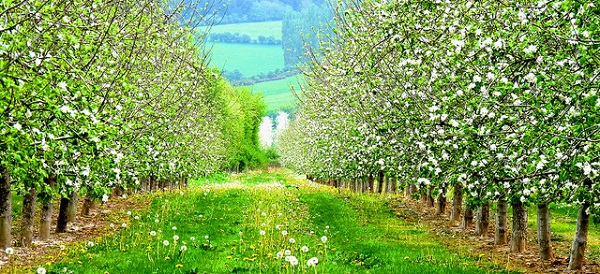
What Trees to Plant
When you are deciding which varieties of tree to plant there are a few of things to consider. The first thing you should do is check with your local extension office to find out what grows best in your area. Some trees will struggle in certain climates and flourish in others. This will also give you guidance on whether or not you have a winter that is cold enough long enough to plant certain varieties. (See tree descriptions below for number of chill hours needed by tree) You will also want to check with your nursery before purchasing a specific variety of tree. If you don’t know how many chill hours your get, check out this article.
 The second thing to consider is the harvest. Plant early and late harvest varieties, so you can extend the time that you have fresh fruit. You also want to plant a hardy, long storage variety so you can store some for winter. At the end of this article is a list of trees to help you with your selection.
The second thing to consider is the harvest. Plant early and late harvest varieties, so you can extend the time that you have fresh fruit. You also want to plant a hardy, long storage variety so you can store some for winter. At the end of this article is a list of trees to help you with your selection.
Last but not least, know how your tree pollinates. Most varieties of apricot, peach, citrus, nectarine and sour cherry are self-pollinating, which means you only need to buy one tree. Self-pollinating trees can pollinate themselves and set their own fruit. Most apple, plum, sweet cherry and pears are the cross-pollinating type, which means you have to buy at least two trees. This allows the pollen from one tree to pollinate and set the fruit of the other tree. If you are not careful, you’ll have barren fruit trees on your hands.
Where to Buy a Tree
 I suggest you go to a local nursery. They usually have a better local variety and expert advice on what grows well in your area. Also, they can usually special order if you are looking for something specific. You can also check with most hardware stores. I have also ordered online from places like Burgess, but each state has its own laws regarding the shipping of live plants. You may not be able to get what you want, but it is worth checking out.
I suggest you go to a local nursery. They usually have a better local variety and expert advice on what grows well in your area. Also, they can usually special order if you are looking for something specific. You can also check with most hardware stores. I have also ordered online from places like Burgess, but each state has its own laws regarding the shipping of live plants. You may not be able to get what you want, but it is worth checking out.
Where to Plant
Deciding where to plant a tree or trees can be tricky, but if you keep all these factors in mind you should do fine.
• Know where your utility lines are underground and avoid them.
• Don’t plant near sewer, septic or water lines.
• Plant your trees north of your garden so you don’t shade your veggies.
• For easier pruning, harvesting and ladder work plant on level ground.
• Avoid having to clean your walkways by planting messy trees away from them.
• Plant attractive flowering trees, like cherries, where everyone can see them.
• Planting close, but not too close, to your house can increase the energy efficiency of your home and reduce noise.
• Keep in mind the future growth or the mature size of your tree.
Companion Planting
Permaculture research shows that you should plant 50% nitrogen fixing plants and 50% production plants. This goes for fruit and nut trees as well. The Nitrogen fixing trees support the production trees by providing both Nitrogen and organic matter for use in composting.
When to Plant a Tree
You want to plant your tree when you are having moderate temperatures and a good amount of rain. Planting is stressful for the tree. You don’t want to plant a tree when it is trying to deal with heat of summer or the cold of winter. Therefore, early spring after the last freeze is the best time to plant. The next best time is in early fall once the temperatures have cooled off and are below 90oF.
How to Plant Your Trees
 The most common mistake people make when planting a tree is the way they dig the hole for the tree. Most tree roots grow outward more than downward, so it is better to dig a wider hole rather than a deeper hole. This will also encourage the roots to grow outward and help stabilize your tree. Here is an article with more details on how to plant. Also, this article has some space saving techniques that you can use when planting.
The most common mistake people make when planting a tree is the way they dig the hole for the tree. Most tree roots grow outward more than downward, so it is better to dig a wider hole rather than a deeper hole. This will also encourage the roots to grow outward and help stabilize your tree. Here is an article with more details on how to plant. Also, this article has some space saving techniques that you can use when planting.
Caring for Your Trees
Whether you plant in the fall or the spring, during the first production season you want to remove any flowers or potential fruit, so that the tree can focus on root development. You can also do some minor pruning to begin developing the leader branches for the shape you want. After the second production season in the late winter, you will need to start  pruning and shaping your tree. You want to keep your trees small for ease of picking and future pruning. For help pruning your trees refer to my article on how to prune your trees.
pruning and shaping your tree. You want to keep your trees small for ease of picking and future pruning. For help pruning your trees refer to my article on how to prune your trees.
If you are growing some of the warm weather exotic fruit trees varieties, you will need to keep them from freezing in winter. There are a few things you can do to help prevent winter damage. The first is protecting your tree with a shade cloth (affiliate link) by either building a frame over your tree or just laying the cloth directly on the tree. Another thing you can do is spray your tree with a seaweed frost protecting solution. The Cytokinins in the seaweed help strengthen the cell walls of the tree. Here are some sample products: Maxicrop, Frost Away, Wilt-Pruf, Frostguard and Frost Shield.
Finally you can put a large number of buckets, pools and barrels of water under your tree and fill them with water. The water acts as thermal mass, and will give off heat at night warming your tree.
Fertilizing Your Trees
I am all for natural fertilizing. In nature a tree has a layer of dead leaves, sticks and other organic material under it. As those things break down they provide a slow but constant flow of nutrients to the roots of a tree. You can try to replicate nature with wood chips and shredded 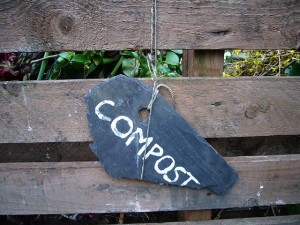 garden scraps or a store bought mulch. Just make sure that the material is made up of a variety of sized pieces. This will also help hold moisture into the earth. Every 4 inches of material can soak up 1 inch of rain water and store it for the trees later use.
garden scraps or a store bought mulch. Just make sure that the material is made up of a variety of sized pieces. This will also help hold moisture into the earth. Every 4 inches of material can soak up 1 inch of rain water and store it for the trees later use.
I suggest just adding compost to your trees throughout the year, but if your trees are showing any of the following signs of malnutrition, then you should test your soil and apply fertilizer appropriately. (More on testing your soil later):
• Slow rate and low amount of growth
• Signs of disease or insect problems
• Smaller than normal leaves
• Leaves that are yellowed or off in color
• Dead branches
• Limb die back
Applying chemical fertilizers is a slippery slope and can lead to toxic and unusable soil. I highly recommend using fertilizer sparingly, and not making it an annual habit.
If you want to give your trees an extra boost you should fertilize in the early spring and the fall. Trees have a growth spurt in early spring, so you want to fertilize them just before they start to come out of dormancy. If your soil is sandy you want to only apply half of your fertilizer before and the other half about 2 weeks after is starts to grow. It is also good to add fertilizer in the fall, so the tree can have some extra help developing roots and fighting off disease.
In general the roots of a tree extend out past the canopy. So when you apply your fertilizer make sure start at the edge of the canopy and put a ring around the entire tree. Also, make sure to put your fertilizer below the roots of any undergrowth. This will ensure that the tree and not the undergrowth gets the nutrients. Be careful not to over fertilize and make sure you provide plenty of water afterwards, so that a salt residue does not build up.
Other Great Resources
Before I get to the list of trees and things you should know about them, I wanted to share these links. They have invaluable information on trees, and will help you plan your orchard.
http://ucmgvideo.ucanr.org/Chuck_Ingles/ – A couple of videos and some downloadable content from the University of California about trees. I highly suggest you set aside a couple of hours and watch these.
http://www.crfg.org/tidbits/ – Some good info and space saving techniques plus info on tropical trees.
https://raintreenursery.com/chill_hours – A great chart of estimated chill hours in your area and a list of trees with a range of their chill hour requirement.
http://www.networkearth.org/perma/culture.html – In this video series Bill Mollison talks about sustainable agriculture. There is four videos about an hour each on trees.
http://tcpermaculture.blogspot.com/2011/05/plants-nitrogen-fixers.html – A detailed list of nitrogen fixing plants including hardiness zone.
http://www.backyardgardener.com/tree/indexlist9.html – A fairly good description of alkaline and acidic soils and what trees grow in which.
More About Pruning Fruit Trees – a fairly detailed list of flowering wood age for pruning
http://edis.ifas.ufl.edu/ – a great database of articles on all sorts of trees and pests.
Things You Need to Know About Your Trees
Apple
 Positives: disease resistant varieties are available, fruit can store for a couple months, usually adaptable to most environments, relatively easy to grow
Positives: disease resistant varieties are available, fruit can store for a couple months, usually adaptable to most environments, relatively easy to grow
Negatives: large range of potential pests, don’t like being planted to close together
USDA Cold Hardiness Zone: 4 to 9
Light: full sun
Soil: neutral PH ideally 6.5, well-fertilized
Water: moist, well-drained
Chill Hours Needed: 400 to 1000 hrs
Pollination: by variety, usually cross pollinating
Age Starts Fruiting: 2 to 5 years
Wood: best fruit grows on 2 or 3 year old wood
Height & Width: standard tree more grew up to 50 feet tall and wide; most modern varieties grow 12~20 feet tall and wide
Growth: medium growth speed
Other Notes: Mid- and late-season apples usually have better flavor and store longer compared with early-season varieties.
Cherry
 Positives: many varieties, can be bushes or trees
Positives: many varieties, can be bushes or trees
Negatives: birds love them so it’s tough to get the most from your harvest
USDA Cold Hardiness Zone: 4 to 8
Light: full sun
Soil: neutral to alkaline PH, well fertilized
Water: moist
Chill Hours Needed: 700 to 800 hrs
Pollination: “sweet” class are usually cross pollinating trees, “sour” class are usually self pollinating bushes, but check with your nursery when you purchase.
Age Starts Fruiting: 3 to 7 years
Wood: best fruit grows on 2 or 3 year old wood
Height & Width: 12 to 20 ft tall and wide
Growth: medium growth speed
Other Notes: These trees are not only productive, but they are beautiful, so feel free to use them as a decorative plant as well.
Pawpaw
 Positives: easy to grow, tastes like banana custard to some, leaves extract a natural insecticide which can be used in a compost tea, fruit is medicinal and tree smells good
Positives: easy to grow, tastes like banana custard to some, leaves extract a natural insecticide which can be used in a compost tea, fruit is medicinal and tree smells good
Negatives: tastes like yucky slime to some people, higher chance of allergic reaction because of the natural insecticide, fruit is soft and doesn’t store well.
USDA Cold Hardiness Zone: 5 to 7
Light: full sun for best fruit, but it is shade tolerant
Soil: neutral to alkaline PH
Water: wet to moist
Chill Hours Needed: 400 to 1000 hrs
Pollination: usually cross pollinating
Age Starts Fruiting: 4 to 8 years
Wood: generally flowers on 1 year old wood
Height & Width: 20 to 35 ft tall and wide
Growth: slow to medium growth speed, spreads by seed or suckering
Peaches and Nectarines
 Positives: home grown peaches have the best flavor
Positives: home grown peaches have the best flavor
Negatives: pest management is more difficult, needs non-compacted deep soil
USDA Cold Hardiness Zone: 5 to 9
Light: full sun
Soil: neutral PH, well fertilized
Water: well drained soil, moist
Chill Hours Needed: 600 to 800 hrs
Pollination: usually self pollinating
Age Starts Fruiting: 3 to 4 years
Wood: generally flowers on 1 year old wood
Height & Width: 10 to 20 ft tall and wide
Growth: medium speed growth, spreads by seed or suckering
Other Notes: needs good airflow to prevent fungal infections
Pears (European & Asian)
 Positives: fresh pairs beat store bought every time, grafting multiple varieties is possible and disease resistant varieties are available
Positives: fresh pairs beat store bought every time, grafting multiple varieties is possible and disease resistant varieties are available
Negatives: can be tricky to get ripe and avoid pests at the same time, since it is usually best to harvest the fruit before it is fully ripe
USDA Cold Hardiness Zone: European: 4 to 7, Asian: 5 to 8
Light: full sun
Soil: neutral PH
Water: moist
Chill Hours Needed: 600 to 800 hrs
Pollination: usually cross pollinating
Age Starts Fruiting: 4 to 6 years
Wood: flowers on 2 to 3 year old wood
Height & Width: depending on variety 15 to 40 ft tall and wide
Growth: medium growth speed
Other Notes: make sure to get a tree grafted onto a fire blight resistant root stock
Lemon, Lime and Orange
 Positives: easy to grow organically, can grow in colder zones if potted and wintered properly, self-pollinating so you only need one
Positives: easy to grow organically, can grow in colder zones if potted and wintered properly, self-pollinating so you only need one
Negatives: sensitive to cold, may need to cover with blanket in below freezing weather
USDA Cold Hardiness Zone: 8b to 11
Light: full sun
Soil: prefer well drained soil with pH levels between 5.5 and 6.5
Water: moist, not soggy
Chill Hours Needed: none
Pollination: most are self pollinating
Age Starts Fruiting: between 3 and 6 years old
Wood: flowers on new wood, so be careful when pruning
Height & Width: Lemons & Limes: 10 to 15 feet tall and wide, Oranges & Grapefruits: 18 to 22 feet tall
Growth: Needs lots of unblocked sun and warmth to set fruit and grow properly
Apricots, Plums, Apriums & Pluots
 Positives: Hard to find in stores, relatively easy to grow
Positives: Hard to find in stores, relatively easy to grow
Negatives: apricots flower early in spring and a late frost can kill the production for that year, fruit doesn’t store well
USDA Cold Hardiness Zone: 4 to 9
Light: full sun
Soil: neutral PH
Water: moist
Chill Hours Needed: Plums: 400 hrs, Apricots: 500 to 600 hrs
Pollination: cross pollinating
Age Starts Fruiting: 2 to 5 years
Wood: flowers on one year old wood
Height & Width: 8 to 15 feet tall and wide
Growth: medium to fast growth, spreads by suckers or seed
Other Notes: birds love to eat your fruits, so you have to harvest a little early and aggressively to beat them
Buckthorn Seaberry
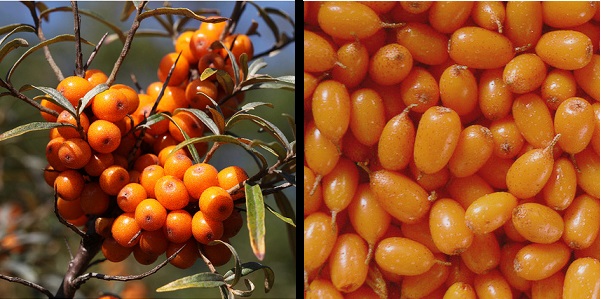 Positives: great medicinal value, can survive in temperatures as low as -40F, it is also a nitrogen fixing tree
Positives: great medicinal value, can survive in temperatures as low as -40F, it is also a nitrogen fixing tree
Negatives: does require annual pruning
USDA Cold Hardiness Zone: 4 to 7
Light: full sun to partial shade
Soil: slightly acidic or alkaline
Water: dry to moist
Chill Hours Needed: 700 to 1500 hrs
Pollination: cross pollinating
Age Starts Fruiting: 3 to 5 years
Wood: flowers on 3 to 4 year old wood
Height & Width: 8 to 15 feet tall and wide
Growth: medium to fast, spreads by suckers
Other Notes: truly a super plant!
Serviceberry or Juneberry
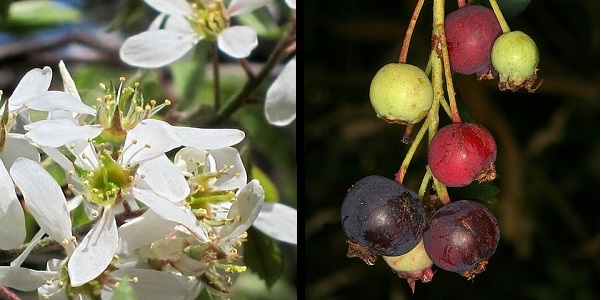
Positives: bears fruit in spring, full of antioxidants
Negatives:
USDA Cold Hardiness Zone: 3 to 9
Light: full sun to partial shade
Soil: neutral to preferably slightly acidic
Water: dry to moist
Chill Hours Needed: by variety 800 to 1000 hrs
Pollination: by variety, some are self pollinating others are cross pollinating
Age Starts Fruiting: 2 to 3 years
Wood: flowers on last years growth, the buds are created in the fall and bloom in the spring
Height & Width: by variety, Juneberry, a tree, can grow 35 to 50 ft tall and 20 to 35 ft wide. Saskatoon, a shrub, grows about 5 to 15 ft tall and wide.
Growth: medium growth speed
Persimmons
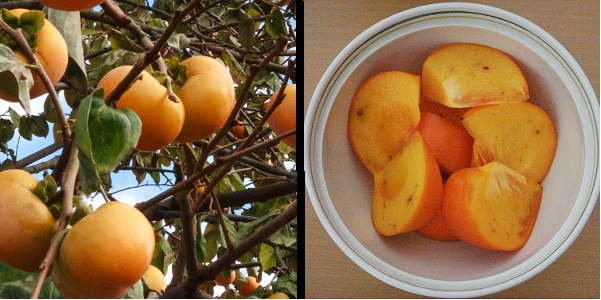 Positives: American persimmons are disease and pest resistant and easy to grow, but have smaller golf ball size fruit. Asian varieties have apple sized fruit and can be grafted on American disease and pest resistant root stock making a perfect combination.
Positives: American persimmons are disease and pest resistant and easy to grow, but have smaller golf ball size fruit. Asian varieties have apple sized fruit and can be grafted on American disease and pest resistant root stock making a perfect combination.
Negatives: Don’t eat the fruit before it is ready to fall off, it will put hair on your chest. You may not like the texture. Deer love them.
USDA Cold Hardiness Zone: 5 to 9
Light: full sun
Soil: slightly acidic or alkaline
Water: dry to moist
Chill Hours Needed: 200 to 400 hrs
Pollination: by variety, most are cross pollinating, some are self pollinating
Age Starts Fruiting: 4 to 6 years
Wood: flowers on new wood
Height & Width: American: 50 to 75 ft tall by 35 to 50 ft wide, Asian: 25 to 40 ft tall by 25 to 40 ft wide
Growth: slow to medium
Other Notes: Ripened fruit often hangs onto the tree well into winter looking like Christmas ornaments.
Pomegranate
 Positives: This super fruit is making a come back. They grow great in the desert and are drought tolerant.
Positives: This super fruit is making a come back. They grow great in the desert and are drought tolerant.
Negatives: May die back in cold winters. Hardy varieties can be hard to find back east, but out west they are fairly prolific.
USDA Cold Hardiness Zone: 7 to 13
Light: full sun to partial shade
Soil: not picky
Water: dry to moist, dislikes wetlands
Chill Hours Needed: 100 to 200 hrs
Pollination: self pollinating
Age Starts Fruiting: 3 to 4 years
Wood: flowers on new wood
Height & Width: about a 20ft sphere
Growth: medium to fast growth depending on water
Other Notes: Because they are usually smaller and bush like, they can be used as understory trees. Be careful though not to over shade them
Figs
 Positives: Figs are a great fruit for a home garden. They have great flavor and produces multiple crops a year.
Positives: Figs are a great fruit for a home garden. They have great flavor and produces multiple crops a year.
Negatives: Fruit doesn’t store well.
USDA Cold Hardiness Zone: 7 to 10
Light: Full Sun
Soil: prefers loamy to clay soils, sandy soil dries out to quickly and increases risk of nematode attack
Water: moist
Chill Hours Needed: 100 to 200 hrs
Pollination: by variety, try to buy self pollinating
Age Starts Fruiting: 2 to 3 years
Wood: spring crop on last years wood, fall crops on new wood
Height & Width: usually 10 to 30ft sphere
Growth: slow to medium growth, spreads via root suckers.
Other Notes: Some varieties require fig wasps to pollinate the main crop. For example, the figs I have are the Desert King. Ironically, the Arizona desert doesn’t have any fig wasps, so I only get the first crop and the second or main crop just shrivels up and falls off the tree.
Quince
 Positives: Great for jellies and jams because of their high pectin content. Hard to find in grocery stores, so it’s nice to grow your own.
Positives: Great for jellies and jams because of their high pectin content. Hard to find in grocery stores, so it’s nice to grow your own.
Negatives: more susceptible to disease in the shade. Might be a little tart for some, but tartness is reduced when cooked into pie and marmalade.
USDA Cold Hardiness Zone: 4 to 9
Light: full sun to partial shade
Soil: neutral PH between 6.1 and 7
Water: moist soil preferred
Chill Hours Needed: 300 to 500 hrs
Pollination: self pollinating
Age Starts Fruiting: 4 to 5 years
Wood: flowers on 1 year old wood
Height & Width: 10 to 20 ft tall and wide
Growth: medium growth rate. Shrub like growth pattern, but can be trained into small trees.
Other Notes: Tolerates Black Walnut’s grown inhibitor juglone, it can be used as a buffer between your walnuts and your other trees. Relative to the apple, so it is susceptible to the same diseases.
Mulberry
 Positives: Very tasty and produce a large crop, lost crops are great for chicken fodder
Positives: Very tasty and produce a large crop, lost crops are great for chicken fodder
Negatives: Hard to harvest from a large tree, and unpicked berries will get everywhere and do stain
USDA Cold Hardiness Zone: 5 to 9
Light: full sun to partial shade
Soil: need deep soil, neutral to slightly alkaline
Water: dry to moist. Somewhat drought tolerant, but do need water in hottest driest periods
Chill Hours Needed: about 400 hrs
Pollination: self pollinated by wind
Age Starts Fruiting: normally 2 to 3 years
Wood: flowers on new wood and on old wood spurs
Height & Width: 30 ft to 50 ft tall and wide, some varieties can get up to 80 ft tall, dwarf varieties are available
Growth: fast growth rate
Other Notes: Black Mulberries are the smallest and live the longest. All Mulberries gather calcium from the soil into it’s fruit.
Almonds
 Positives: Beautiful flowers. Almonds are still pricey in stores. I did some math once and estimated that if I grew 10 almond trees, I would have enough almonds for a year’s supply of almond milk.
Positives: Beautiful flowers. Almonds are still pricey in stores. I did some math once and estimated that if I grew 10 almond trees, I would have enough almonds for a year’s supply of almond milk.
Negatives: Almonds bloom really early in spring, so a late spring frost can ruin all of your fruit. Fruit isn’t edible, only the seed.
USDA Cold Hardiness Zone: 7 to 9
Light: full sun to partial shade
Soil: alkaline to acidic
Water: moist to dry, needs to dry out a little between waterings
Chill Hours Needed: 500 to 600 hrs
Pollination: by variety, but usually cross pollinating
Age Starts Fruiting: 2 to 4 years
Wood: flowers on old spurs and sprigs
Height & Width: 15 to 30 ft tall and 10 to 15 ft wide
Growth: medium to fast growing
Other Notes: Make sure to buy sweet almonds, not bitter almonds. Almonds are elated to peaches and apricots. They are different and the bitter one’s contain cyanide. Look for an interesting cross between an apricot and an almond that will produce edible fruit and nuts on one tree.
Chestnuts
 Positives: Productive trees with large fruits. Dwarf varieties are available.
Positives: Productive trees with large fruits. Dwarf varieties are available.
Negatives: The tree is normally very large 100+ ft tall and 50 ft wide
USDA Cold Hardiness Zone: 4 to 8
Light: full sun to partial shade
Soil: neutral to acidic
Water: dry to moist
Chill Hours Needed: 400 to 500 hrs
Pollination: self pollinating
Age Starts Fruiting: 3 to 5 years
Wood: flower on new wood
Height & Width: Chinese chestnuts grow about 30 ft tall, the dwarf Chinquapin grows about 10 to 20 ft tall and wide
Growth: moderately fast growers
Other Notes: chestnuts are great roasted
Filberts or Hazelnuts
 Positives: High yielding and drought tolerant, grows on slopes and in marginal soils
Positives: High yielding and drought tolerant, grows on slopes and in marginal soils
Negatives: can be subject to blight
USDA Cold Hardiness Zone: 4 to 8
Light: full sun
Soil: best in moderately acidic soil to neutral soil
Water: dry to moist. Somewhat drought tolerant
Chill Hours Needed: 800 to 1200 hrs
Pollination: cross pollinating
Age Starts Fruiting: 6 to 8+ years
Wood: flowers on one year old wood
Height & Width: bushes up to 10 ft high, trees about 30 ft high
Growth: medium to fast growth. Naturally a bush, but can be trained into a short tree.
Other Notes: leaves turn a beautiful orange in the fall.
Walnuts
 Positives: If grown for wood, you could fetch a premium price.
Positives: If grown for wood, you could fetch a premium price.
Negatives: Slow growing and slow to produce, fairly high water demand.
USDA Cold Hardiness Zone: Black Walnut: 4 to 7, English/Persian Walnut: Zone 7 to 9
Light: full sun
Soil: slightly acidic to slightly alkaline
Water: soil can’t be to sandy or to heavy with clay, need moist well drained
Chill Hours Needed: 600 to 700 hrs
Pollination: cross pollinating
Age Starts Fruiting: 4 to 7 years
Wood: flowers on new wood
Height & Width: 50 to 100 ft tall
Growth: slow
Other Notes: roots excrete juglone, a growth inhibitor for many plants, so keep them well away from your gardens
Pecans
 Positives: Produces good shade in addition to it’s nuts. Pecans are also some of the easiest nuts to crack open.
Positives: Produces good shade in addition to it’s nuts. Pecans are also some of the easiest nuts to crack open.
Negatives: It is a large tree, which makes harvesting more difficult. It is also really slow to mature.
USDA Cold Hardiness Zone: 5 to 8
Light: full sun
Soil: neutral to alkaline
Water: dry to moist
Chill Hours Needed: 650 to 1,550 hrs
Pollination: self pollinating
Age Starts Fruiting: 10 years from seed, 4 to 8 from graft
Wood: flowers on new wood
Height & Width: 100 ft tall and 30 to 50 ft wide
Growth: slow growth
Support Trees (Nitrogen Fixing)
Palo Verde (Blue, Green and Foothill)
 Positives: Drought tolerant. Doesn’t provide much shade, so works well for companion planting.
Positives: Drought tolerant. Doesn’t provide much shade, so works well for companion planting.
USDA Cold Hardiness Zone: by variety, 6 to 11
Light: full sun
Soil: slightly acid to alkaline
Water: dry
Height & Width: 20 to 30 ft tall and wide
Growth: fast growing
Honey Mesquite
 Positives: Drought tolerant. Pulls nutrients from deep in the earth to the surface. Fixes nitrogen into the ground. Great companion tree.
Positives: Drought tolerant. Pulls nutrients from deep in the earth to the surface. Fixes nitrogen into the ground. Great companion tree.
Negatives: Usually has thorns
USDA Cold Hardiness Zone: 7 to 11
Light: full sun
Soil: desert soil is preferred
Water: dry to moist
Height & Width: 30 to 50 ft tall and up to 100 ft spread
Growth: fast growing
Other Notes: Don’t over water, this will cause the tree to grow too quickly and become weak. Fruit pods on the Honey Mesquite are sweet and can be used to make flour, or as fodder for your livestock.
Alders
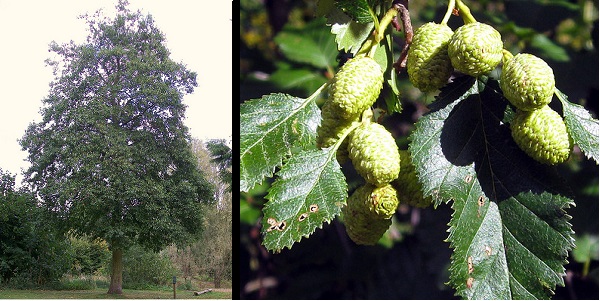 Positives: large tree, great for screening, reclamation or shade. Does well in the open, may consider as wind break between fields. Trunk is fairly straight and wood is hard, which makes it good for constructing furniture.
Positives: large tree, great for screening, reclamation or shade. Does well in the open, may consider as wind break between fields. Trunk is fairly straight and wood is hard, which makes it good for constructing furniture.
USDA Cold Hardiness Zone: 3A to 7B
Light: full sun, partial sun or partial shade
Soil: slightly alkaline to slightly acidic
Water: prefer moist, some tolerate dryer soils
Height & Width: 40 to 50 feet tall and 20 to 40 foot wide
Growth: moderate to fast growing
Other Notes: many varieties fix nitrogen (red, common, Arizona, New Mexico, and more)
Black Locust/Robinia
 Positives: Can be pruned with an open canopy to allow for undergrowth, drought tolerant
Positives: Can be pruned with an open canopy to allow for undergrowth, drought tolerant
Negatives: pods are poisonous
USDA Cold Hardiness Zone: 4A to 8B
Light: full sun, partial sun or partial shade
Soil: clay; sand; loam; alkaline; acidic; well-drained
Water: moist to dry
Height & Width: 30 to 50 feet tall and 20 to 35 feet wide
Growth: fast growing
Other Notes: many varieties available (Frisia, Purple Robe and Umbrella)
Honeylocust
 Positives: large attractive tree with beautiful yellow leaves in the fall, drought tolerant
Positives: large attractive tree with beautiful yellow leaves in the fall, drought tolerant
Negatives: some varieties have large thorns, but thornless varieties are available.
USDA Cold Hardiness Zone: 3A to 8A
Light: full sun, partial sun or partial shade
Soil: clay; sand; loam; alkaline; acidic; occasionally wet; well-drained
Water: moist to dry
Height & Width: 50 to 75 feet tall and 35 to 50 feet wide
Growth: fast growing
Other Notes: many varieties available (Imperial, Shademaster and Skyline)
Cassia Tree
 Positives: beautiful clusters of yellow flowers
Positives: beautiful clusters of yellow flowers
Negatives: doesn’t tolerate freezes
USDA Cold Hardiness Zone: 10B to 11
Light: full sun
Soil: clay; sand; loam; slightly alkaline; acidic; well-drained
Water: moist
Height & Width: 15 to 20 feet tall and wide
Growth: fast growing
Other Notes: Many varieties, even bush like ones available.
Texas Mountain Laurel
 Positives: beautiful and aromatic purple/blue flowers, drought tolerant
Positives: beautiful and aromatic purple/blue flowers, drought tolerant
Negatives: seeds are poisonous
USDA Cold Hardiness Zone: 7B to 10A
Light: full sun, partial sun or partial shade
Soil: clay; sand; loam; alkaline; well-drained
Water: moist to dry
Height & Width: 15 to 25 feet tall and 10 foot wide
Growth: slow growing
Mimosa Tree
 Positives: pretty pink flowers, drought tolerant, semi-open canopy allows for undergrowth
Positives: pretty pink flowers, drought tolerant, semi-open canopy allows for undergrowth
Negatives: wood is not super strong and is known to break
USDA Cold Hardiness Zone: 6B to 9B
Light: full sun
Soil: clay; sand; loam; slightly alkaline; acidic; occasionally wet; well-drained
Water: moist to dry
Height & Width: 15 to 25 feet tall and 25 to 35 feet wide
Growth: fast growing
Other Notes: very prolific, once you have one, you’ll have seedlings popping up everywhere, which is good and bad.
For more organic gardening tips and a FREE copy of my book 221 Tips & Tricks from Master Gardeners Illustrated! subscribe here:
References
Pollination
http://www.lowes.com/projects/gardening-and-outdoor/cross-pollinate-fruit-trees/project
Placement
http://www.arborday.org/trees/righttreeandplace/
http://www.wikihow.com/Choose-Where-to-Plant-Trees
Fertilizing
http://www.extension.umn.edu/garden/yard-garden/trees-shrubs/tree-fertilization-guide/
http://www.treecaretips.org/fertilization/should_i_fertilize.htm
http://www.treehelp.com/how-to-fertilize-a-tree/
Freezing protection
http://www.crfg.org/tidbits/bkydfrostprot.html
Summaries of different trees
http://parksandpeople.org/files/resources/2540_Success%20with%20Fruit%20Trees%20in%20Urban%20Areas.pdf
http://www.motherearthnews.com/organic-gardening/all-about-growing-fruit-trees-zm0z14fmzsto.aspx#axzz38Km3JlYR
http://www.crfg.org/pubs/ff/
Plants Per Region
http://www.raintreenursery.com/Regional_Plants.html
Good summary on nut trees
http://www.garden.org/ediblelandscaping/?page=october_nuts
http://www.food-skills-for-self-sufficiency.com/growing-nuts.html
http://www.hobbyfarms.com/crops-and-gardening/nut-varieties.aspx
Good list of trees that sell well
http://www.profitableplants.com/5-most-profitable-nut-trees-to-grow/
Grows on what kind of wood
http://www.apple-works.com/pruning.html
http://www.garden.org/ediblelandscaping/?page=pruning-fruit
Cashews
http://www.tropicalpermaculture.com/growing-cashews.html
Citrus
Overwintering – http://www.gardena.com/ie/garden-life/garden-magazine/everything-you-have-always-wanted-to-know-about-citrus-trees-and-overwintering-them/
http://homeguides.sfgate.com/soil-lemon-tree-plant-60135.html
http://homeguides.sfgate.com/lemon-tree-need-pollinated-another-lemon-tree-60046.html
http://www.almanac.com/plant/lemons-oranges
http://forums.gardenweb.com/forums/load/citrus/msg091150191961.html
Figs
http://forums.gardenweb.com/forums/load/azgard/msg0902162021003.html?22
http://www.organicgardening.com/learn-and-grow/fig-trees-growing-guide
Pawpaw
http://pubs.ext.vt.edu/438/438-105/438-105.html
http://www.pawpaw.kysu.edu/faq.htm#q14
Seaberry
http://www.crfg.org/chapters/golden_gate/Berries.pdf
http://davesgarden.com/community/forums/t/877656/#b
http://forums.gardenweb.com/forums/load/edible/msg0721351420083.html?51
Serviceberry
http://www.learn2grow.com/gardeningguides/trees/featuredplants/AmelanchierAtYourService.aspx
http://www.gardeningknowhow.com/edible/fruits/serviceberries/growing-serviceberries.htm
http://perrysperennials.info/articles/shad.html
http://www.degroot-inc.com/product_info.php?products_id=39
Persimmons
https://answers.yahoo.com/question/index?qid=20081212193039AAQHIgO
http://ucanr.edu/blogs/napanewspaper/index.cfm?tagname=Fuyu
http://www.clemson.edu/extension/hgic/plants/vegetables/tree_fruits_nuts/hgic1357.html
Pomegranates
http://patwelsh.com/wpmu/blog/trees/how-to-make-a-pomegranate-tree-bear-fruit/
http://www.edible-landscape-design.com/growing-pomegranates.html
http://www.ndsu.edu/pubweb/chiwonlee/plsc368/student/papers03/abraun/abraun/htmlformat.htm
Quince
http://www.justfruitsandexotics.com/JFE/product-category/fruit-trees/quince/
http://tcpermaculture.blogspot.com/2011/10/permaculture-plants-quince-tree.html
Successful Farming – by Frank D. Gardner 1916
Almonds
http://www.fast-growing-trees.com/NePlusAlmondTree.htm
http://www.gardeningblog.net/how-to-grow/almonds/
http://www.flemings.com.au/documents/pruning_multi_page.pdf
http://www.mortonarb.org/files/Pruning%20deciduous%20shrubs%20by%20species.pdf
Filberts or Hazelnuts
http://davesgarden.com/guides/pf/go/937/#b
Walnuts
http://homeguides.sfgate.com/good-dirt-walnut-trees-45251.html
http://tcpermaculture.blogspot.com/2011/10/permaculture-plants-walnut-trees.html
Pecan
http://tcpermaculture.blogspot.com/2013/03/permaculture-plants-pecans-and-hickory.html
Fruit bearing age
http://www.ladybug.uconn.edu/factsheets/tp_05_fruittreesfailtobeal.html
http://www.starkbros.com/blog/how-many-years-berries/
http://www.starkbros.com/blog/how-many-years/
http://www.starkbros.com/blog/nut-trees-how-many-years-until-harvest/
Chill Hours Needed
http://www.davewilson.com/product-information-general/special-topics/fruit-tree-chilling-requirement
http://www.raintreenursery.com/chill_hours.html
A large list of desert plants
http://www.public.asu.edu/~camartin/plants/Plant%20html%20files/
Palo Verde
http://homeguides.sfgate.com/palo-verde-tree-look-like-99855.html
http://www.public.asu.edu/~camartin/plants/Plant%20html%20files/parkinsoniaaculeata.html
Mesquite
http://www.public.asu.edu/~camartin/plants/Plant%20html%20files/honeymesquite.html
http://www.public.asu.edu/~camartin/plants/Plant%20html%20files/chileanmesquite.html
http://edis.ifas.ufl.edu/st502
Alders
http://www.moray.gov.uk/downloads/file58111.pdf
http://edis.ifas.ufl.edu/st070
http://www.cascadehardwood.com/our-resources
Black Locust
http://edis.ifas.ufl.edu/topic_locust
Honeylocust
http://edis.ifas.ufl.edu/topic_thornless_honeylocust
Cassia Tree
http://edis.ifas.ufl.edu/st588
Texas Mountain Laurel
http://edis.ifas.ufl.edu/st597
Mimosa
http://edis.ifas.ufl.edu/st068



Hello there, very informative website. I thought I would let you know some minor slip ups. Under your listing for Pawpaw, the sliced-open fruit that you show in the photo on the right is a Papaya, not a pawpaw. The photo on the left is indeed a pawpaw.
Both of your photos for the Juneberry/ serviceberry section show a Highbush Cranberry. While edible, its not nearly as tasty as and actually juneberry as I’m sure you know.
That’s all, don’t mean to be rude or anything. Thanks for a great read!
Thank You Greg!
I’ve made those corrections. I appreciate you pointing that out to me.
Glad you enjoyed the article, it means a lot to me. Don’t forget to join my email list to get notified of future articles.
Cheers,
Stephen
Amazing write up, thank you so much. I’m in zone 5b and constantly looking to green up my thumbs.
Thank you. What is your favorite tree in your garden?
I have a small garden with mango, lychee and guava trees. I am thinking to add more fruits in my garden.This article was very useful and informative
Those would be great additions. You should do it.
Enjoyed,gracias mil.